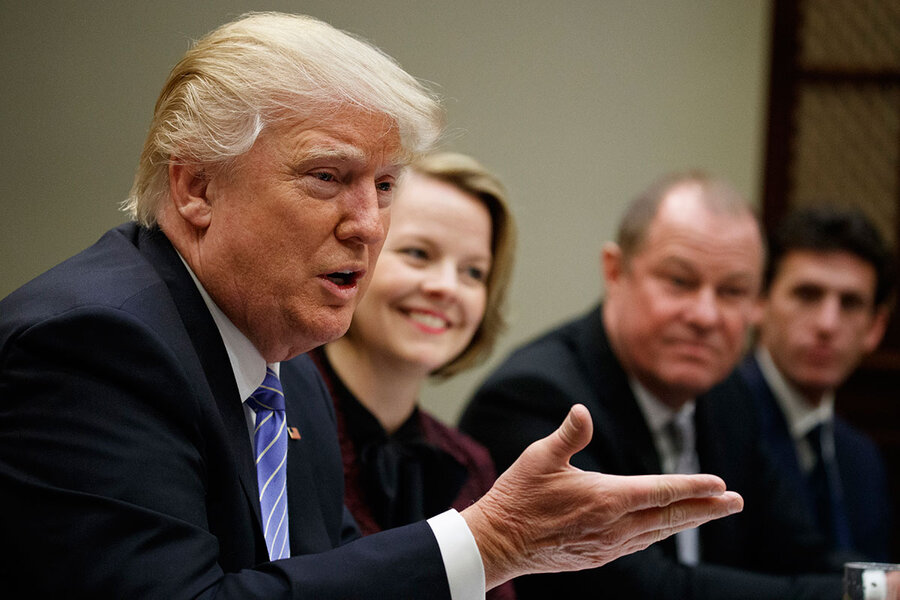What America without the NEA and NEH would look like, and why that matters
Loading...
President Trump has said he wants to build American infrastructure – even as he proposes cutting funding for so-called cultural infrastructure.
Four cultural federal organizations, including the National Endowment for the Arts (NEA) and the National Endowment for the Humanities (NEH), have for years been the target of conservative critics. But now the groups could see their funding gone as Mr. Trump on Thursday submitted his proposed budget to the Senate.
For arts and cultural groups across the country, the four agencies – although they account for only 0.02 percent of federal spending – have long been considered crucial in supporting outreach to underserved communities between the coasts, particularly in rural areas. Proponents of the proposed cuts have said that the proposed elimination of the agencies will open the door to a freer arts market that forces artists to produce works that speak to local audiences, rather than to bureaucrats in Washington.
But opponents of the plan say that – ironically – the elimination of the arts agencies will do most damage in some of the parts of the country that had supported Trump the most.
The NEA – in addition to the NEH, the Institute of Museum and Library Services (IMLS), and the Corporation for Public Broadcasting (CPB) – was created in 1965 as a way to nurture cultural activities. The NEA has often come under scrutiny for funding controversial artwork such as Andres Serrano's photograph "Piss Christ" (1987) and Robert Gober's color print "Genital Wallpaper" (1989). Grants from the NEA were regarded by many conservatives as a form of welfare for liberal elites.
But the NEA's support of local artists is more than just funding, says Laura Zabel, executive director of Springboard for the Arts. And its influence is felt all across the United States, she says, not just in liberal enclaves. For the last five years, for example, Springboard for the Arts, which is an economic development group based in St. Paul and Fergus Falls, Minn., has received “Our Town” funding from the NEA, intended to support “creative placemaking” and community storytelling in Fergus Falls.
In the 2016 presidential election, 64 percent of Fergus Falls voters chose Trump.
The impact of the NEA money on a town like Fergus Falls is significant, says Ms. Zabel. “It is a relatively small amount of investment, but even more important than the money is the symbolism of supporting arts and culture,” she tells The Christian Science Monitor in an interview on Thursday. “The NEA is one of the most important ways that the federal government that it listens to rural communities and it supports rural communities and their sense of culture and identities and very directly their economy.”
Though the budgets of the four agencies are negligible in the larger scheme of federal government spending – $148 million each for NEA and NEH, $445 million for CPB, and $230 million for IMLS – the federal dollars are often used to leverage state, local, and private funding. Particularly when it comes to the NEA, its grants often act as the basis for matching funds from the states, according to Ann Wicks, spokeswoman of the New England Foundation for the Arts, a regional arts organization.
“The reality is that, the slice of the federal budget the NEA takes up is teeny tiny,” Ms. Wicks tells the Monitor. “However, it's enough to generate and to leverage additional public and private support…. And it's an important case-maker and visibility-creator for the arts nationally.”
In the case of Springboard in Fergus Falls, this funding system has helped the group attain an additional $1,155,000 investment on top of its $145,000 grant from the NEA between 2011 and 2016, says Zabel. This nearly 10:1 return rate on the investment is not uncommon, Wicks says, as in their district, every dollar from the federal government was matched by approximately $9 of public and private support.
Such “a ripple effect,” according to Wicks, has made it possible for NEFA to expand access and resources across congressional districts from Boston to Maine and throughout rural areas in the New England region.
Speaking with the Monitor from an event at a rural town in South Carolina, Pam Breaux, CEO of the National Assembly of State Arts Agencies, says everything around her “is indicative of the public benefits of the arts to rural communities.” With arts agencies in 56 states and jurisdictions, the assembly has found that collectively 25 percent of the state grant allocations go to rural communities, where private funding is not as prevalent, she says.
“Rural areas and low-income communities specifically would suffer disproportionately from significant reductions in funding from the NEA,” she says.
But some question how much "trickle down" effect there really is from government spending on the arts. The NEA saw its budget rise from nearly $3 million in 1966 to $148 million in 2016. Yet, according to a 2015 report by the NEA, Americans’ participation in arts activities – ranging from attending a live performance and going to the movies, to reading books – has declined from 39 percent in 2002 to 33 percent in 2012.
This “contradiction” in efforts and results offers strong support to the drive to end federal funding, says NEA critic David Marcus, who is also the artistic director of the Blue Box World, a Brooklyn-based theater project (which receives no federal funding). Calling the elimination of the NEA “the best thing for the arts in decades,” he described “a closed art economy” where many theater companies with subsidies get barely half of their revenue from ticket sales – a scenario that he says is counterproductive to creating a competitive art economy.
“What's happening when producing companies get funded is that you lose any aspect of creative destruction, so when you unsubsidize companies that are actually trying to tighten their belts and create new ways to bring in more audience, not for-profit companies and the companies that the NEA funds are more incentivized to go after grants than they are to go after the audiences,” Mr. Marcus tells the Monitor in a phone interview. “That's having negative effect on theater participation and creating more diverse audiences.”
Marcus said the loss of NEA funding will not stop people from making art. In fact, without the NEA “picking winners and losers,” he is optimistic that some real changes in the art form will be created and grow within a free market, citing examples such as jazz and standup comedy.
“Arts existed before the NEA,” he says. “Should the NEA be cut, art will exist after the NEA.”
Marcus’s ideas are not new. In a 1997 report, the Heritage Foundation’s Stuart Butler listed 10 reasons to support of the funding cuts for the arts, arguing that “the arts were flowering before the NEA.” According to a recent report by the Bureau of Economic Analysis, the art and cultural production contributed more than $704 billion to the US economy in 2013, accounting for 4.2 percent of the US GDP.
But for Zabel, the loss of NEA means an erosion to the democratizing process that will lead to the loss of artistic and economic opportunities for artists in small towns outside the high-wealth coastal, urban cities.
“It concerns me because I think that [nurturing] culture and community as economic opportunities is part of how rural and small communities outside of the coasts are going to survive and thrive into the future,” she says. “A sense of place, a sense of identity, and a sense of culture, that's about our basic humanity.”






